Attached files
| file | filename |
|---|---|
| EX-99.1 - EX-99.1 - Stitch Fix, Inc. | exhibit991-q320.htm |
| 8-K - 8-K - Stitch Fix, Inc. | sfix-20200608.htm |
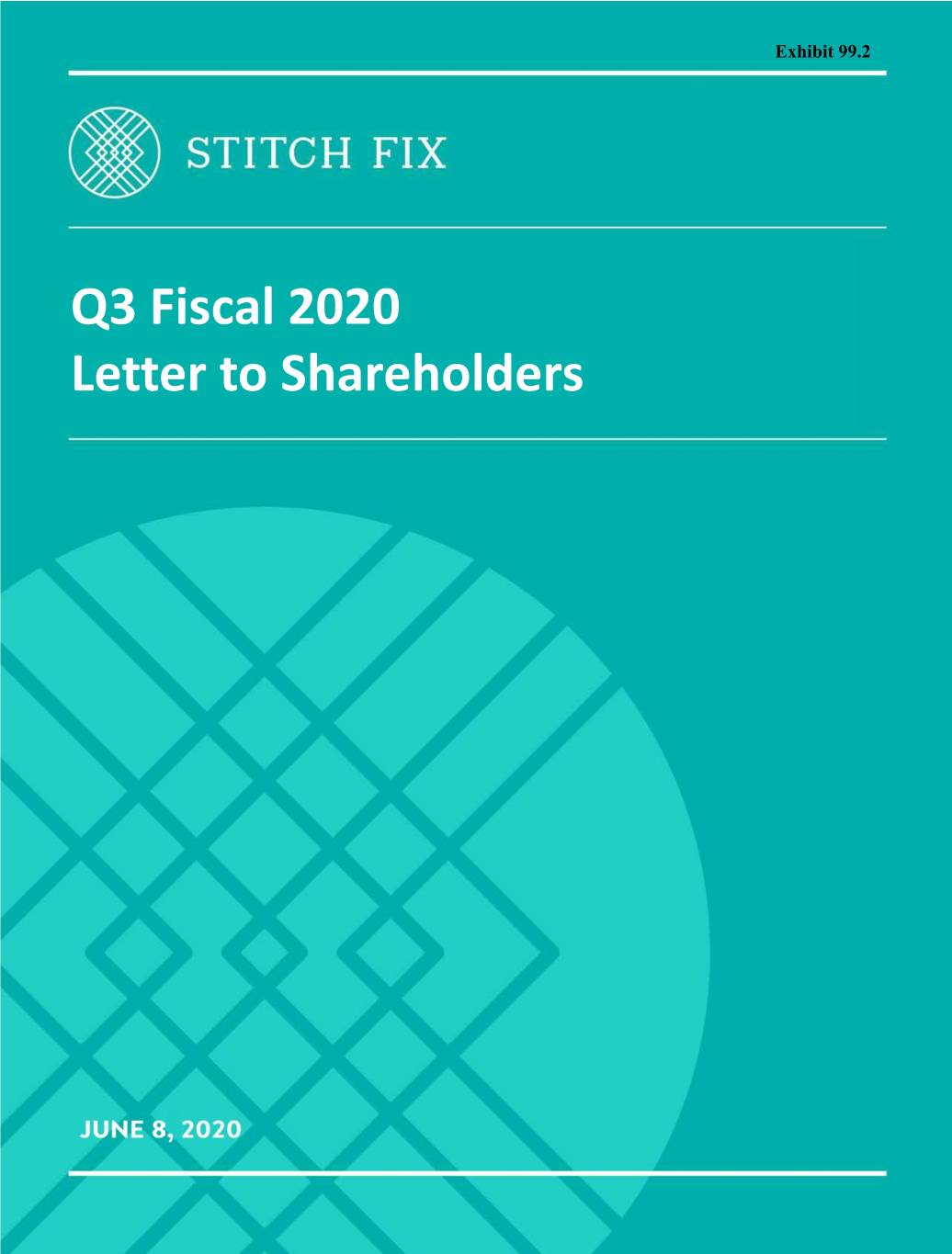
Exhibit 99.2 Q3 Fiscal 2020 Letter to Shareholders
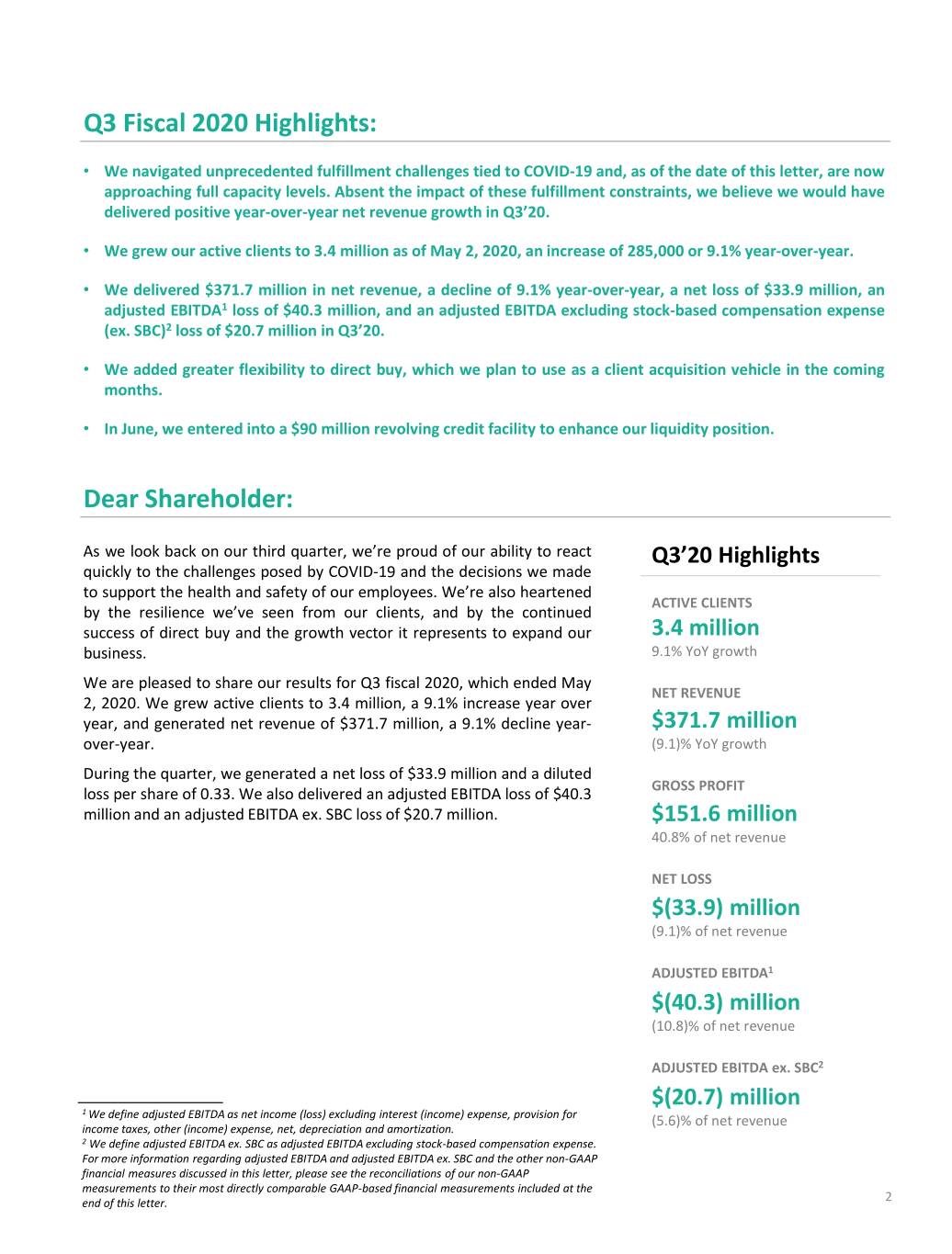
Q3 Fiscal 2020 Highlights: • We navigated unprecedented fulfillment challenges tied to COVID-19 and, as of the date of this letter, are now approaching full capacity levels. Absent the impact of these fulfillment constraints, we believe we would have delivered positive year-over-year net revenue growth in Q3’20. • We grew our active clients to 3.4 million as of May 2, 2020, an increase of 285,000 or 9.1% year-over-year. • We delivered $371.7 million in net revenue, a decline of 9.1% year-over-year, a net loss of $33.9 million, an adjusted EBITDA1 loss of $40.3 million, and an adjusted EBITDA excluding stock-based compensation expense (ex. SBC)2 loss of $20.7 million in Q3’20. • We added greater flexibility to direct buy, which we plan to use as a client acquisition vehicle in the coming months. • In June, we entered into a $90 million revolving credit facility to enhance our liquidity position. Dear Shareholder: As we look back on our third quarter, we’re proud of our ability to react Q3’20 Highlights quickly to the challenges posed by COVID-19 and the decisions we made to support the health and safety of our employees. We’re also heartened by the resilience we’ve seen from our clients, and by the continued ACTIVE CLIENTS success of direct buy and the growth vector it represents to expand our 3.4 million business. 9.1% YoY growth We are pleased to share our results for Q3 fiscal 2020, which ended May NET REVENUE 2, 2020. We grew active clients to 3.4 million, a 9.1% increase year over year, and generated net revenue of $371.7 million, a 9.1% decline year- $371.7 million over-year. (9.1)% YoY growth During the quarter, we generated a net loss of $33.9 million and a diluted loss per share of 0.33. We also delivered an adjusted EBITDA loss of $40.3 GROSS PROFIT million and an adjusted EBITDA ex. SBC loss of $20.7 million. $151.6 million 40.8% of net revenue NET LOSS $(33.9) million (9.1)% of net revenue ADJUSTED EBITDA1 $(40.3) million (10.8)% of net revenue ADJUSTED EBITDA ex. SBC2 1 $(20.7) million We define adjusted EBITDA as net income (loss) excluding interest (income) expense, provision for (5.6)% of net revenue income taxes, other (income) expense, net, depreciation and amortization. 2 We define adjusted EBITDA ex. SBC as adjusted EBITDA excluding stock-based compensation expense. For more information regarding adjusted EBITDA and adjusted EBITDA ex. SBC and the other non-GAAP financial measures discussed in this letter, please see the reconciliations of our non-GAAP measurements to their most directly comparable GAAP-based financial measurements included at the end of this letter. 2
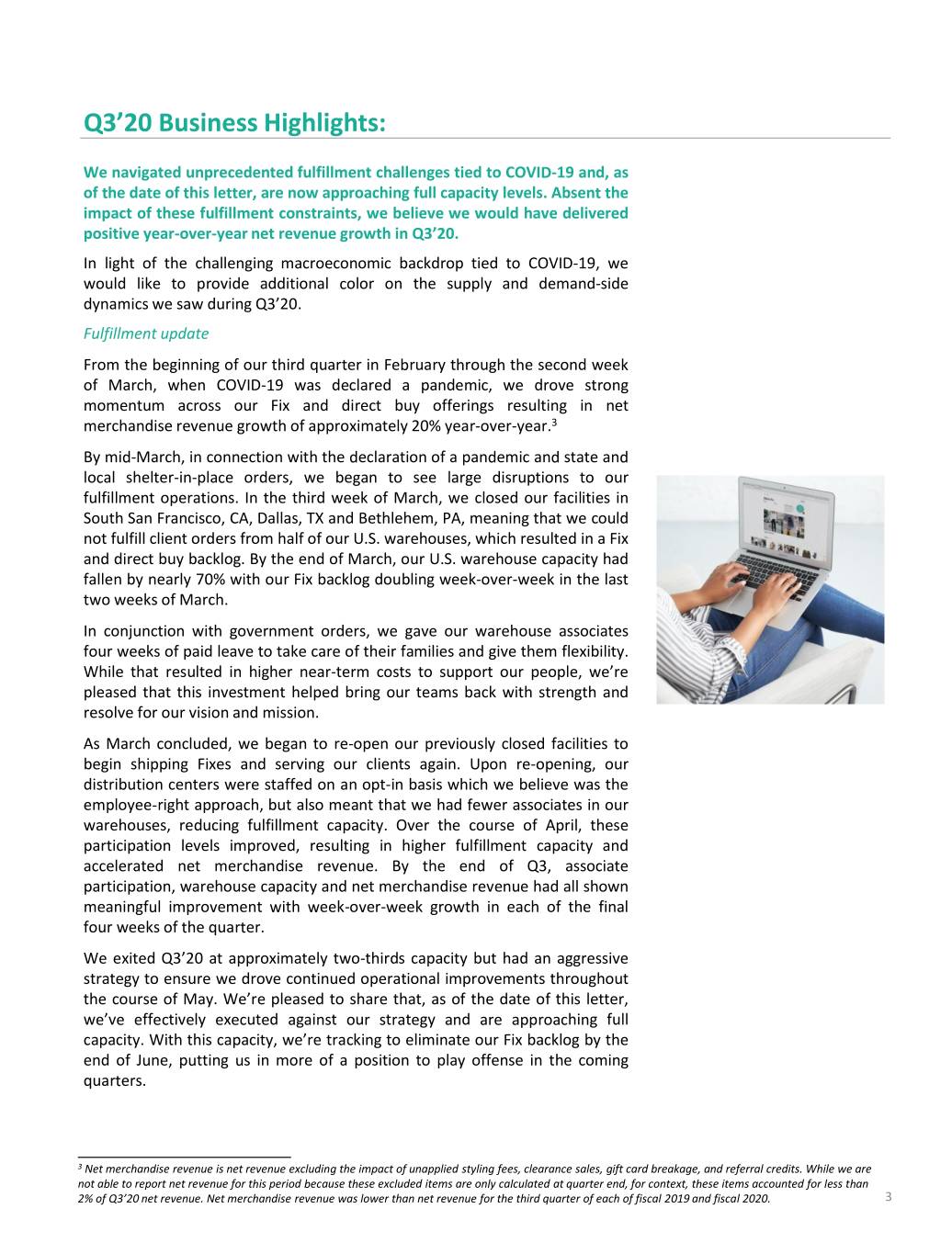
Q3’20 Business Highlights: We navigated unprecedented fulfillment challenges tied to COVID-19 and, as of the date of this letter, are now approaching full capacity levels. Absent the impact of these fulfillment constraints, we believe we would have delivered positive year-over-year net revenue growth in Q3’20. In light of the challenging macroeconomic backdrop tied to COVID-19, we would like to provide additional color on the supply and demand-side dynamics we saw during Q3’20. Fulfillment update From the beginning of our third quarter in February through the second week of March, when COVID-19 was declared a pandemic, we drove strong momentum across our Fix and direct buy offerings resulting in net merchandise revenue growth of approximately 20% year-over-year.3 By mid-March, in connection with the declaration of a pandemic and state and local shelter-in-place orders, we began to see large disruptions to our fulfillment operations. In the third week of March, we closed our facilities in South San Francisco, CA, Dallas, TX and Bethlehem, PA, meaning that we could not fulfill client orders from half of our U.S. warehouses, which resulted in a Fix and direct buy backlog. By the end of March, our U.S. warehouse capacity had fallen by nearly 70% with our Fix backlog doubling week-over-week in the last two weeks of March. In conjunction with government orders, we gave our warehouse associates four weeks of paid leave to take care of their families and give them flexibility. While that resulted in higher near-term costs to support our people, we’re pleased that this investment helped bring our teams back with strength and resolve for our vision and mission. As March concluded, we began to re-open our previously closed facilities to begin shipping Fixes and serving our clients again. Upon re-opening, our distribution centers were staffed on an opt-in basis which we believe was the employee-right approach, but also meant that we had fewer associates in our warehouses, reducing fulfillment capacity. Over the course of April, these participation levels improved, resulting in higher fulfillment capacity and accelerated net merchandise revenue. By the end of Q3, associate participation, warehouse capacity and net merchandise revenue had all shown meaningful improvement with week-over-week growth in each of the final four weeks of the quarter. We exited Q3’20 at approximately two-thirds capacity but had an aggressive strategy to ensure we drove continued operational improvements throughout the course of May. We’re pleased to share that, as of the date of this letter, we’ve effectively executed against our strategy and are approaching full capacity. With this capacity, we’re tracking to eliminate our Fix backlog by the end of June, putting us in more of a position to play offense in the coming quarters. 3 Net merchandise revenue is net revenue excluding the impact of unapplied styling fees, clearance sales, gift card breakage, and referral credits. While we are not able to report net revenue for this period because these excluded items are only calculated at quarter end, for context, these items accounted for less than 2% of Q3’20 net revenue. Net merchandise revenue was lower than net revenue for the third quarter of each of fiscal 2019 and fiscal 2020. 3
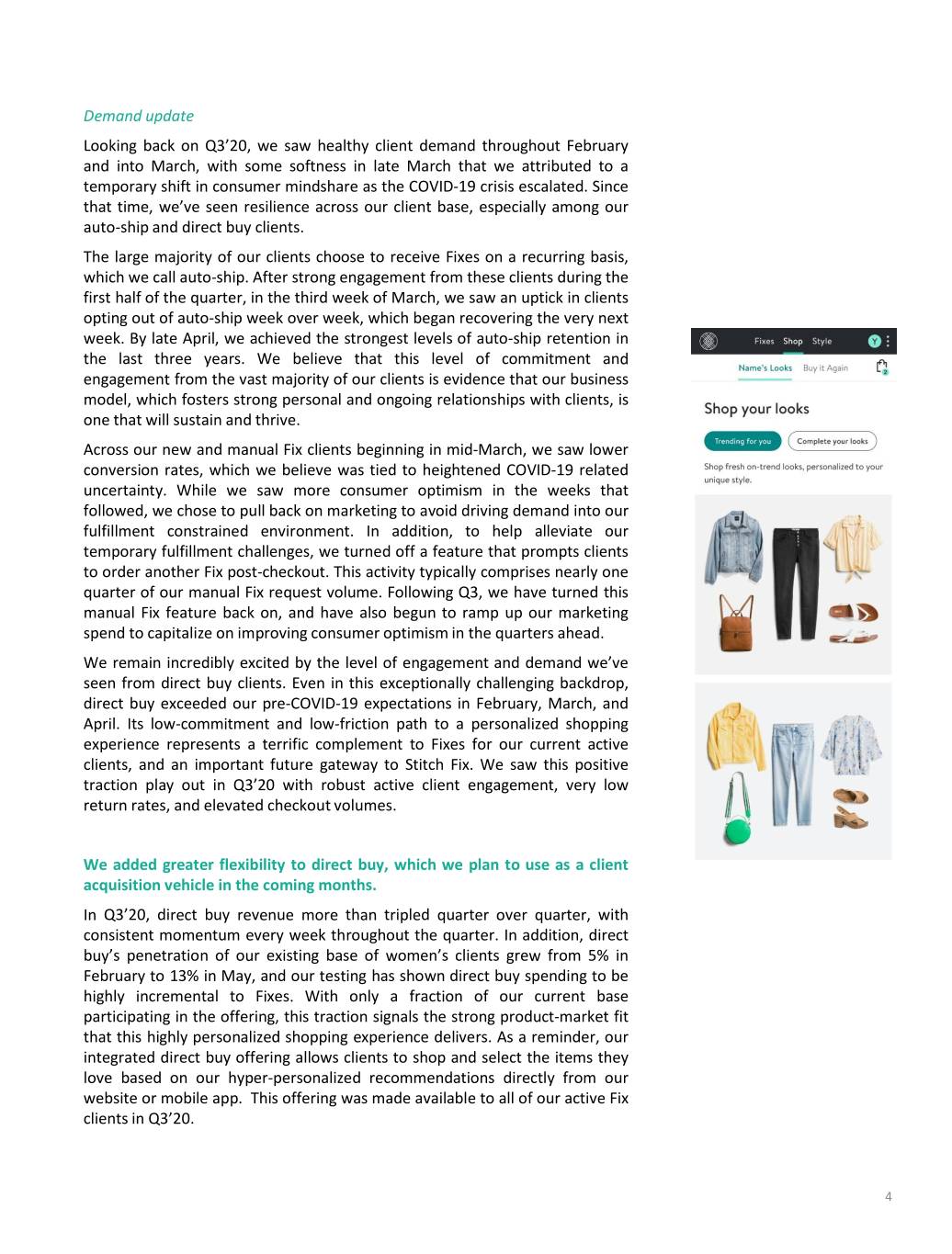
Demand update Looking back on Q3’20, we saw healthy client demand throughout February and into March, with some softness in late March that we attributed to a temporary shift in consumer mindshare as the COVID-19 crisis escalated. Since that time, we’ve seen resilience across our client base, especially among our auto-ship and direct buy clients. The large majority of our clients choose to receive Fixes on a recurring basis, which we call auto-ship. After strong engagement from these clients during the first half of the quarter, in the third week of March, we saw an uptick in clients opting out of auto-ship week over week, which began recovering the very next week. By late April, we achieved the strongest levels of auto-ship retention in the last three years. We believe that this level of commitment and engagement from the vast majority of our clients is evidence that our business model, which fosters strong personal and ongoing relationships with clients, is one that will sustain and thrive. Across our new and manual Fix clients beginning in mid-March, we saw lower conversion rates, which we believe was tied to heightened COVID-19 related uncertainty. While we saw more consumer optimism in the weeks that followed, we chose to pull back on marketing to avoid driving demand into our fulfillment constrained environment. In addition, to help alleviate our temporary fulfillment challenges, we turned off a feature that prompts clients to order another Fix post-checkout. This activity typically comprises nearly one quarter of our manual Fix request volume. Following Q3, we have turned this manual Fix feature back on, and have also begun to ramp up our marketing spend to capitalize on improving consumer optimism in the quarters ahead. We remain incredibly excited by the level of engagement and demand we’ve seen from direct buy clients. Even in this exceptionally challenging backdrop, direct buy exceeded our pre-COVID-19 expectations in February, March, and April. Its low-commitment and low-friction path to a personalized shopping experience represents a terrific complement to Fixes for our current active clients, and an important future gateway to Stitch Fix. We saw this positive traction play out in Q3’20 with robust active client engagement, very low return rates, and elevated checkout volumes. We added greater flexibility to direct buy, which we plan to use as a client acquisition vehicle in the coming months. In Q3’20, direct buy revenue more than tripled quarter over quarter, with consistent momentum every week throughout the quarter. In addition, direct buy’s penetration of our existing base of women’s clients grew from 5% in February to 13% in May, and our testing has shown direct buy spending to be highly incremental to Fixes. With only a fraction of our current base participating in the offering, this traction signals the strong product-market fit that this highly personalized shopping experience delivers. As a reminder, our integrated direct buy offering allows clients to shop and select the items they love based on our hyper-personalized recommendations directly from our website or mobile app. This offering was made available to all of our active Fix clients in Q3’20. 4
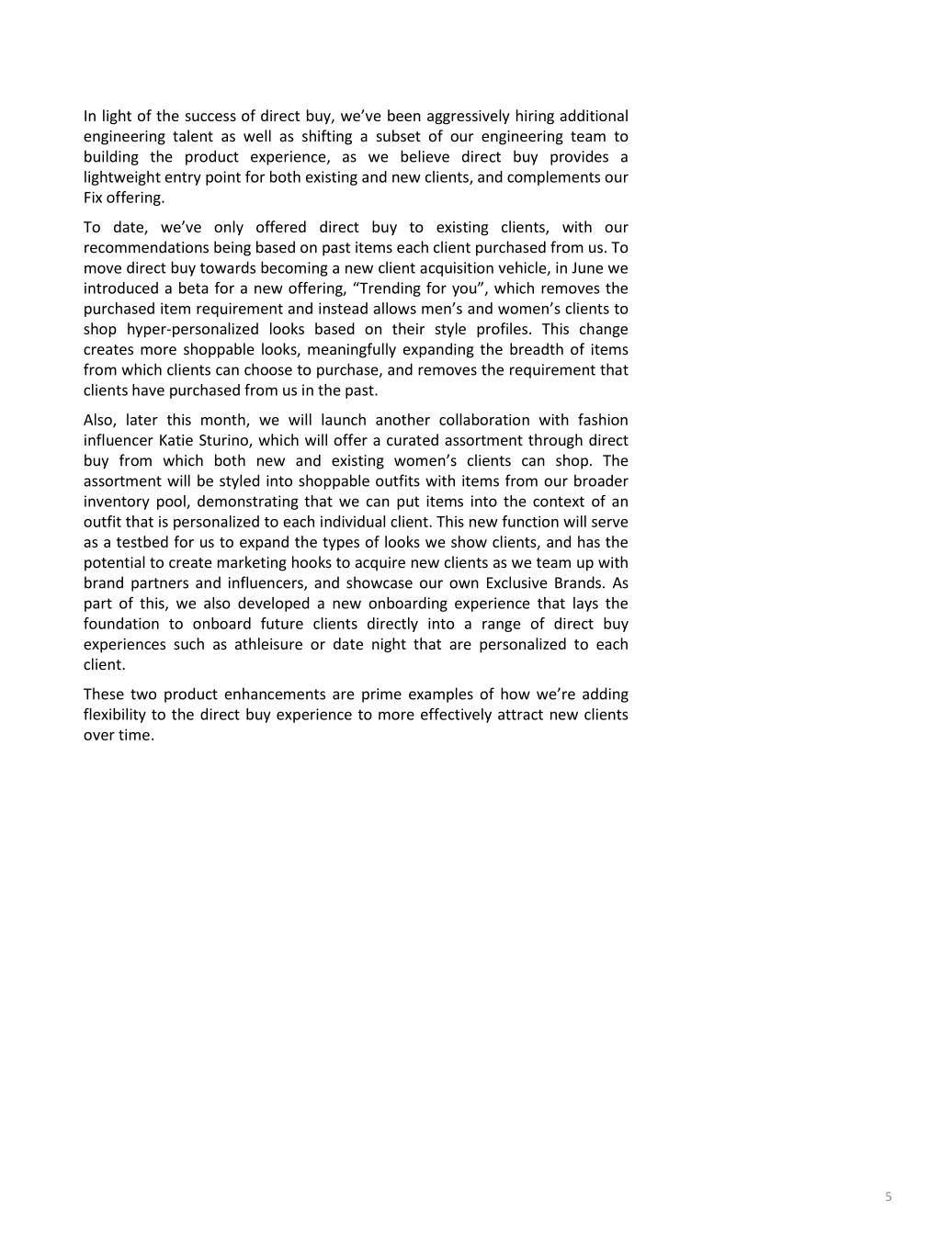
In light of the success of direct buy, we’ve been aggressively hiring additional engineering talent as well as shifting a subset of our engineering team to building the product experience, as we believe direct buy provides a lightweight entry point for both existing and new clients, and complements our Fix offering. To date, we’ve only offered direct buy to existing clients, with our recommendations being based on past items each client purchased from us. To move direct buy towards becoming a new client acquisition vehicle, in June we introduced a beta for a new offering, “Trending for you”, which removes the purchased item requirement and instead allows men’s and women’s clients to shop hyper-personalized looks based on their style profiles. This change creates more shoppable looks, meaningfully expanding the breadth of items from which clients can choose to purchase, and removes the requirement that clients have purchased from us in the past. Also, later this month, we will launch another collaboration with fashion influencer Katie Sturino, which will offer a curated assortment through direct buy from which both new and existing women’s clients can shop. The assortment will be styled into shoppable outfits with items from our broader inventory pool, demonstrating that we can put items into the context of an outfit that is personalized to each individual client. This new function will serve as a testbed for us to expand the types of looks we show clients, and has the potential to create marketing hooks to acquire new clients as we team up with brand partners and influencers, and showcase our own Exclusive Brands. As part of this, we also developed a new onboarding experience that lays the foundation to onboard future clients directly into a range of direct buy experiences such as athleisure or date night that are personalized to each client. These two product enhancements are prime examples of how we’re adding flexibility to the direct buy experience to more effectively attract new clients over time. 5
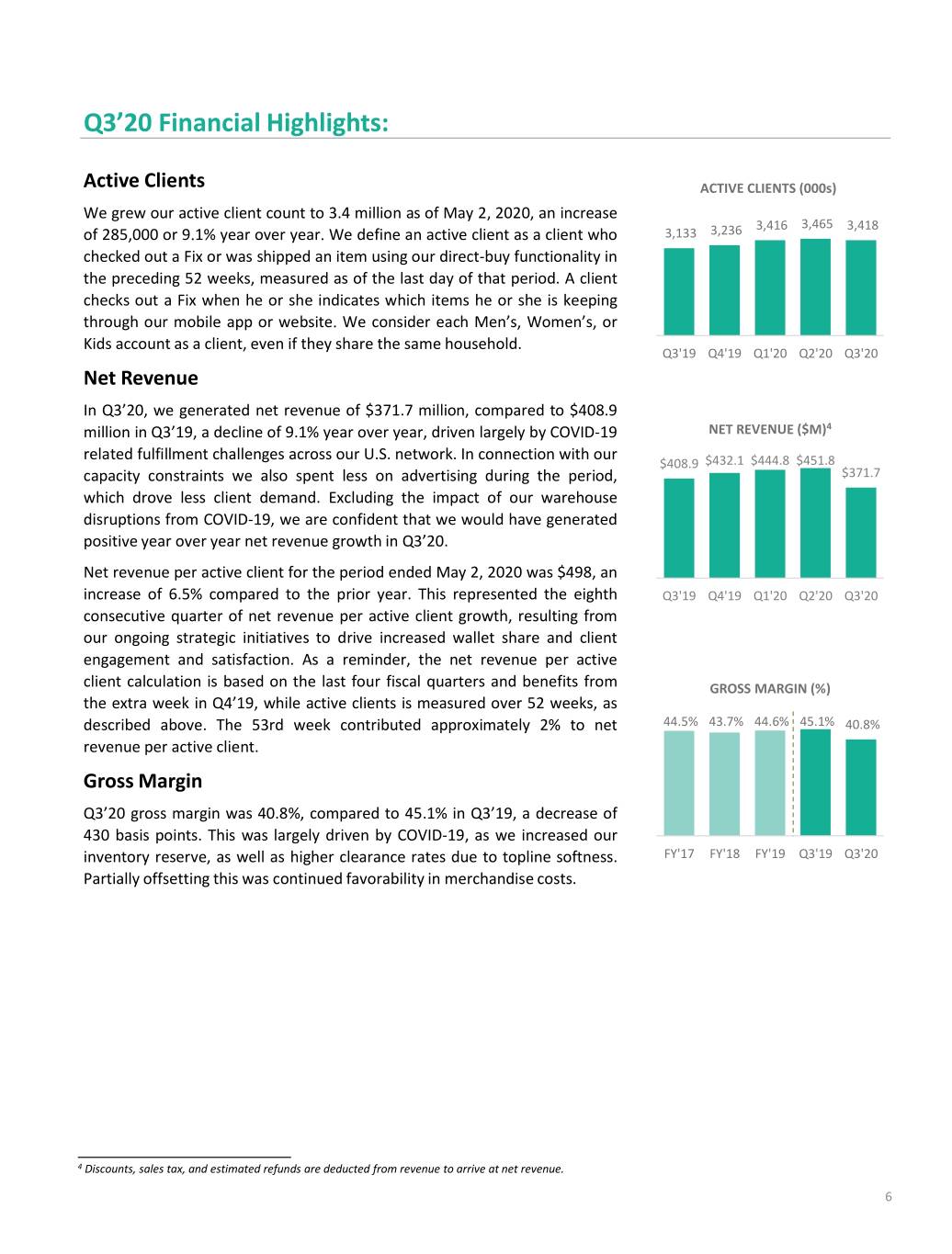
Q3’20 Financial Highlights: Active Clients ACTIVE CLIENTS (000s) We grew our active client count to 3.4 million as of May 2, 2020, an increase 3,416 3,465 3,418 of 285,000 or 9.1% year over year. We define an active client as a client who 3,133 3,236 checked out a Fix or was shipped an item using our direct-buy functionality in the preceding 52 weeks, measured as of the last day of that period. A client checks out a Fix when he or she indicates which items he or she is keeping through our mobile app or website. We consider each Men’s, Women’s, or Kids account as a client, even if they share the same household. Q3'19 Q4'19 Q1'20 Q2'20 Q3'20 Net Revenue In Q3’20, we generated net revenue of $371.7 million, compared to $408.9 million in Q3’19, a decline of 9.1% year over year, driven largely by COVID-19 NET REVENUE ($M)4 related fulfillment challenges across our U.S. network. In connection with our $408.9 $432.1 $444.8 $451.8 capacity constraints we also spent less on advertising during the period, $371.7 which drove less client demand. Excluding the impact of our warehouse disruptions from COVID-19, we are confident that we would have generated positive year over year net revenue growth in Q3’20. Net revenue per active client for the period ended May 2, 2020 was $498, an increase of 6.5% compared to the prior year. This represented the eighth Q3'19 Q4'19 Q1'20 Q2'20 Q3'20 consecutive quarter of net revenue per active client growth, resulting from our ongoing strategic initiatives to drive increased wallet share and client engagement and satisfaction. As a reminder, the net revenue per active client calculation is based on the last four fiscal quarters and benefits from GROSS MARGIN (%) the extra week in Q4’19, while active clients is measured over 52 weeks, as described above. The 53rd week contributed approximately 2% to net 44.5% 43.7% 44.6% 45.1% 40.8% revenue per active client. Gross Margin Q3’20 gross margin was 40.8%, compared to 45.1% in Q3’19, a decrease of 430 basis points. This was largely driven by COVID-19, as we increased our inventory reserve, as well as higher clearance rates due to topline softness. FY'17 FY'18 FY'19 Q3'19 Q3'20 Partially offsetting this was continued favorability in merchandise costs. 4 Discounts, sales tax, and estimated refunds are deducted from revenue to arrive at net revenue. 6
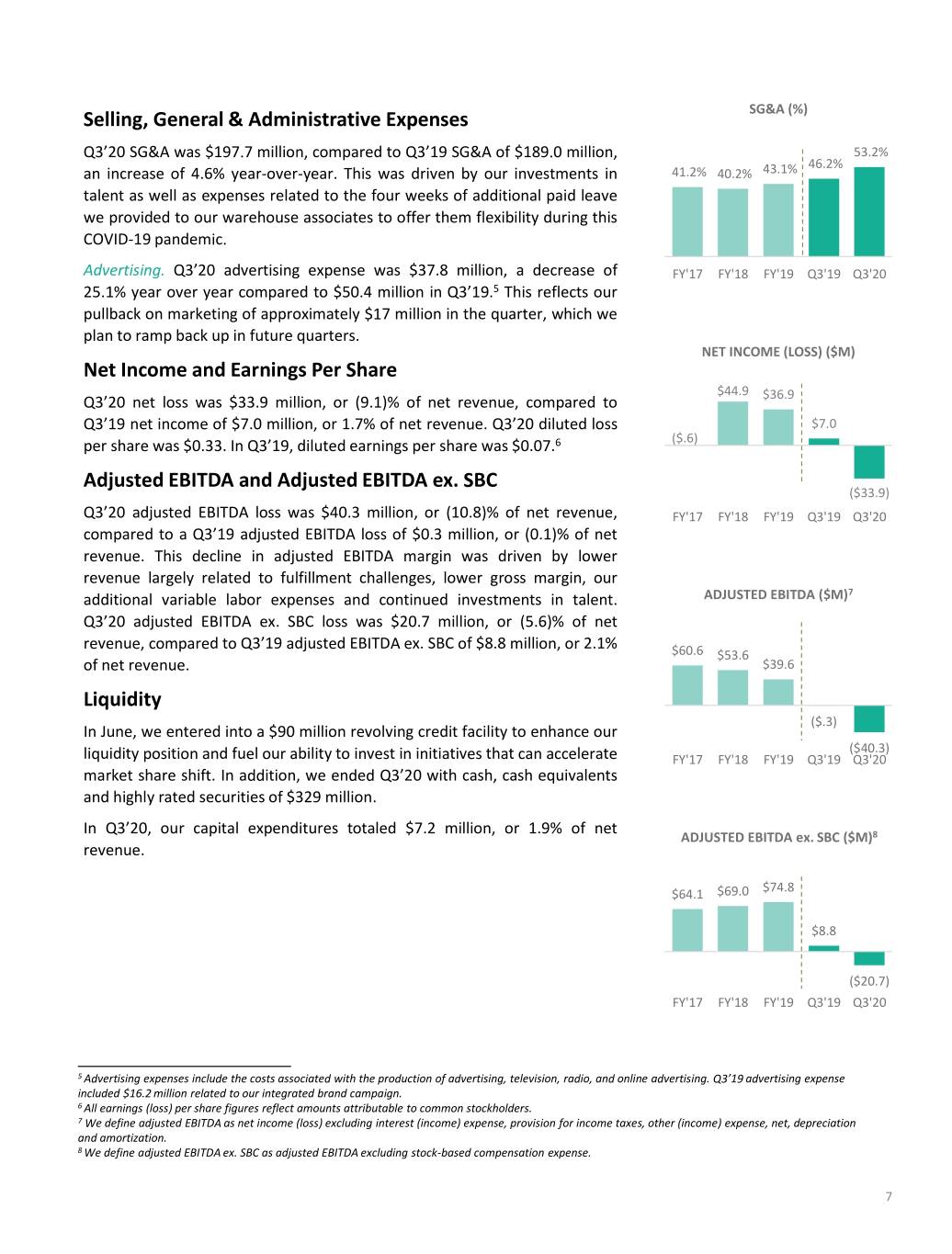
SG&A (%) Selling, General & Administrative Expenses Q3’20 SG&A was $197.7 million, compared to Q3’19 SG&A of $189.0 million, 53.2% 46.2% an increase of 4.6% year-over-year. This was driven by our investments in 41.2% 40.2% 43.1% talent as well as expenses related to the four weeks of additional paid leave we provided to our warehouse associates to offer them flexibility during this COVID-19 pandemic. Advertising. Q3’20 advertising expense was $37.8 million, a decrease of FY'17 FY'18 FY'19 Q3'19 Q3'20 25.1% year over year compared to $50.4 million in Q3’19.5 This reflects our pullback on marketing of approximately $17 million in the quarter, which we plan to ramp back up in future quarters. NET INCOME (LOSS) ($M) Net Income and Earnings Per Share $44.9 Q3’20 net loss was $33.9 million, or (9.1)% of net revenue, compared to $36.9 Q3’19 net income of $7.0 million, or 1.7% of net revenue. Q3’20 diluted loss $7.0 per share was $0.33. In Q3’19, diluted earnings per share was $0.07.6 ($.6) Adjusted EBITDA and Adjusted EBITDA ex. SBC ($33.9) Q3’20 adjusted EBITDA loss was $40.3 million, or (10.8)% of net revenue, FY'17 FY'18 FY'19 Q3'19 Q3'20 compared to a Q3’19 adjusted EBITDA loss of $0.3 million, or (0.1)% of net revenue. This decline in adjusted EBITDA margin was driven by lower revenue largely related to fulfillment challenges, lower gross margin, our additional variable labor expenses and continued investments in talent. ADJUSTED EBITDA ($M)7 Q3’20 adjusted EBITDA ex. SBC loss was $20.7 million, or (5.6)% of net revenue, compared to Q3’19 adjusted EBITDA ex. SBC of $8.8 million, or 2.1% $60.6 $53.6 of net revenue. $39.6 Liquidity ($.3) In June, we entered into a $90 million revolving credit facility to enhance our ($40.3) liquidity position and fuel our ability to invest in initiatives that can accelerate FY'17 FY'18 FY'19 Q3'19 Q3'20 market share shift. In addition, we ended Q3’20 with cash, cash equivalents and highly rated securities of $329 million. In Q3’20, our capital expenditures totaled $7.2 million, or 1.9% of net ADJUSTED EBITDA ex. SBC ($M)8 revenue. $74.8 $64.1 $69.0 $8.8 ($20.7) FY'17 FY'18 FY'19 Q3'19 Q3'20 5 Advertising expenses include the costs associated with the production of advertising, television, radio, and online advertising. Q3’19 advertising expense included $16.2 million related to our integrated brand campaign. 6 All earnings (loss) per share figures reflect amounts attributable to common stockholders. 7 We define adjusted EBITDA as net income (loss) excluding interest (income) expense, provision for income taxes, other (income) expense, net, depreciation and amortization. 8 We define adjusted EBITDA ex. SBC as adjusted EBITDA excluding stock-based compensation expense. 7
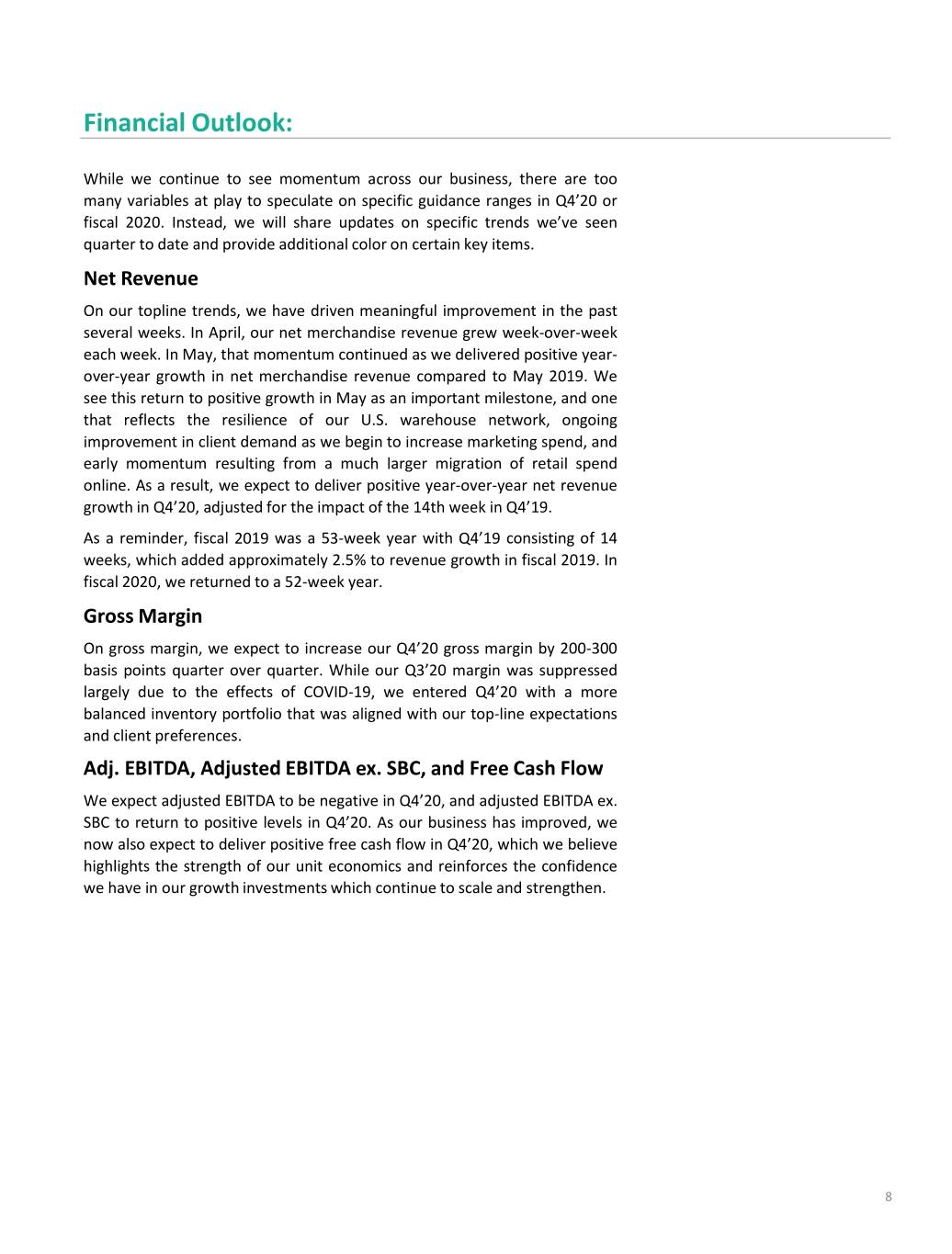
Financial Outlook: While we continue to see momentum across our business, there are too many variables at play to speculate on specific guidance ranges in Q4’20 or fiscal 2020. Instead, we will share updates on specific trends we’ve seen quarter to date and provide additional color on certain key items. Net Revenue On our topline trends, we have driven meaningful improvement in the past several weeks. In April, our net merchandise revenue grew week-over-week each week. In May, that momentum continued as we delivered positive year- over-year growth in net merchandise revenue compared to May 2019. We see this return to positive growth in May as an important milestone, and one that reflects the resilience of our U.S. warehouse network, ongoing improvement in client demand as we begin to increase marketing spend, and early momentum resulting from a much larger migration of retail spend online. As a result, we expect to deliver positive year-over-year net revenue growth in Q4’20, adjusted for the impact of the 14th week in Q4’19. As a reminder, fiscal 2019 was a 53-week year with Q4’19 consisting of 14 weeks, which added approximately 2.5% to revenue growth in fiscal 2019. In fiscal 2020, we returned to a 52-week year. Gross Margin On gross margin, we expect to increase our Q4’20 gross margin by 200-300 basis points quarter over quarter. While our Q3’20 margin was suppressed largely due to the effects of COVID-19, we entered Q4’20 with a more balanced inventory portfolio that was aligned with our top-line expectations and client preferences. Adj. EBITDA, Adjusted EBITDA ex. SBC, and Free Cash Flow We expect adjusted EBITDA to be negative in Q4’20, and adjusted EBITDA ex. SBC to return to positive levels in Q4’20. As our business has improved, we now also expect to deliver positive free cash flow in Q4’20, which we believe highlights the strength of our unit economics and reinforces the confidence we have in our growth investments which continue to scale and strengthen. 8
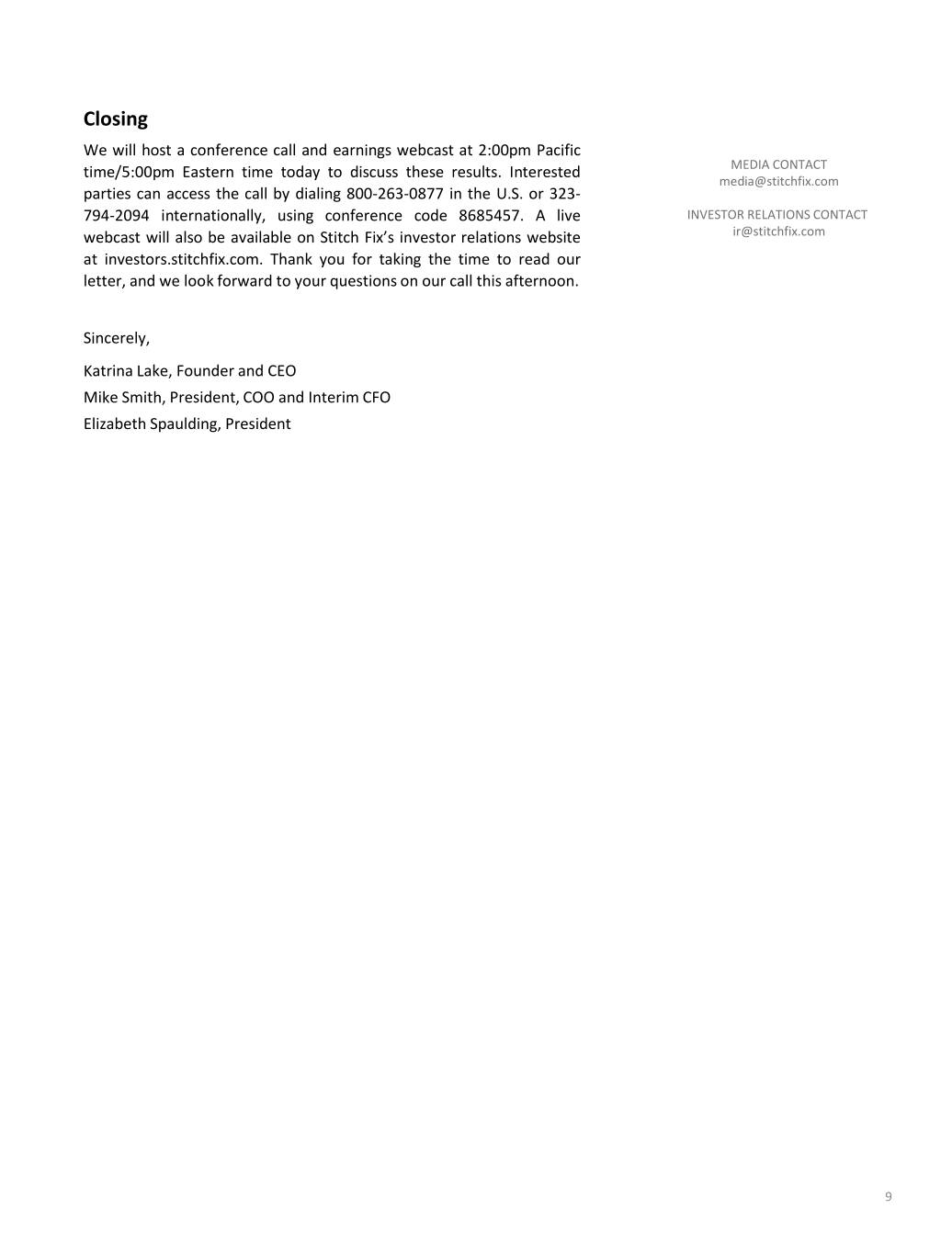
Closing We will host a conference call and earnings webcast at 2:00pm Pacific time/5:00pm Eastern time today to discuss these results. Interested MEDIA CONTACT media@stitchfix.com parties can access the call by dialing 800-263-0877 in the U.S. or 323- 794-2094 internationally, using conference code 8685457. A live INVESTOR RELATIONS CONTACT webcast will also be available on Stitch Fix’s investor relations website ir@stitchfix.com at investors.stitchfix.com. Thank you for taking the time to read our letter, and we look forward to your questions on our call this afternoon. Sincerely, Katrina Lake, Founder and CEO Mike Smith, President, COO and Interim CFO Elizabeth Spaulding, President 9
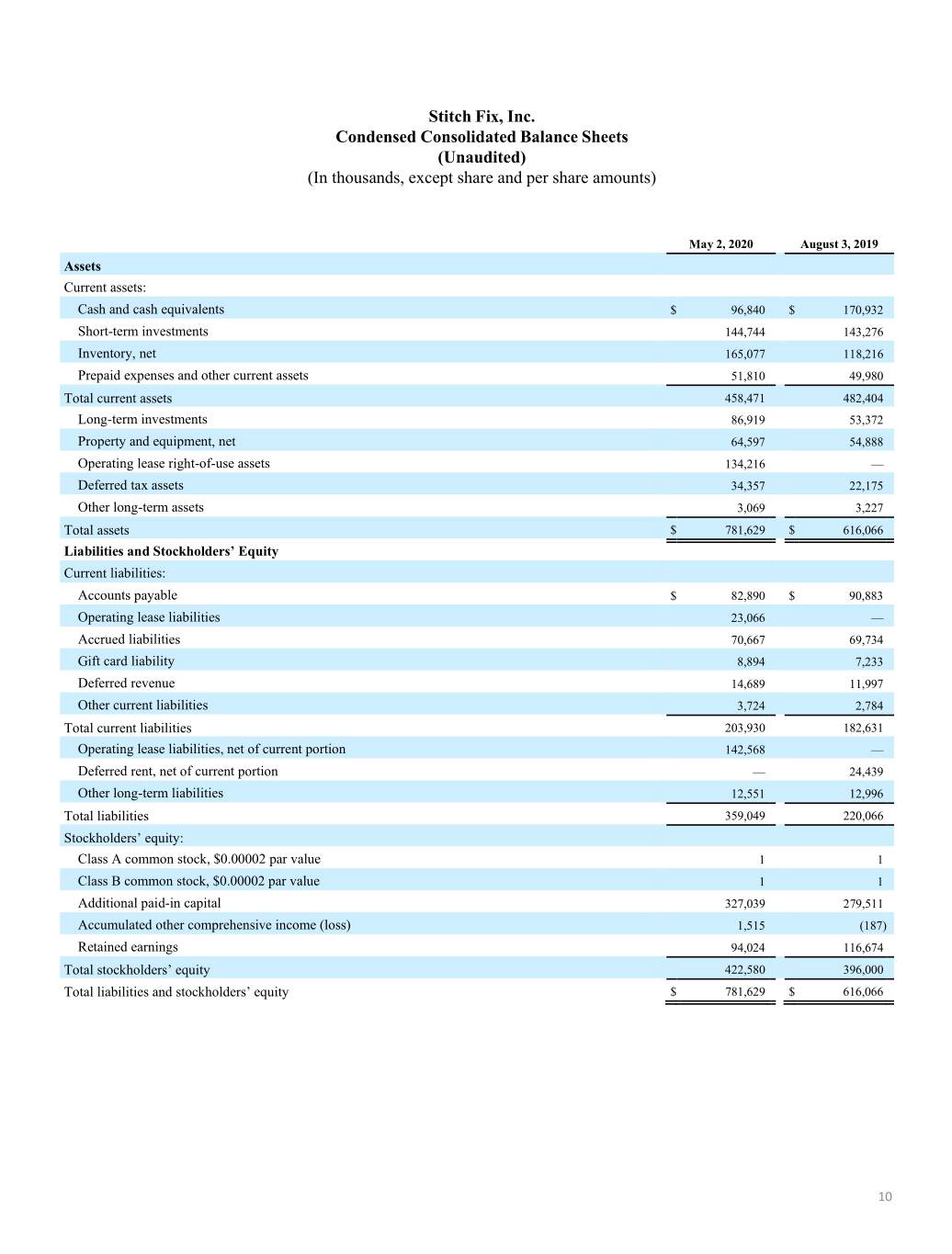
Stitch Fix, Inc. Condensed Consolidated Balance Sheets (Unaudited) (In thousands, except share and per share amounts) May 2, 2020 August 3, 2019 Assets Current assets: Cash and cash equivalents $ 96,840 $ 170,932 Short-term investments 144,744 143,276 Inventory, net 165,077 118,216 Prepaid expenses and other current assets 51,810 49,980 Total current assets 458,471 482,404 Long-term investments 86,919 53,372 Property and equipment, net 64,597 54,888 Operating lease right-of-use assets 134,216 — Deferred tax assets 34,357 22,175 Other long-term assets 3,069 3,227 Total assets $ 781,629 $ 616,066 Liabilities and Stockholders’ Equity Current liabilities: Accounts payable $ 82,890 $ 90,883 Operating lease liabilities 23,066 — Accrued liabilities 70,667 69,734 Gift card liability 8,894 7,233 Deferred revenue 14,689 11,997 Other current liabilities 3,724 2,784 Total current liabilities 203,930 182,631 Operating lease liabilities, net of current portion 142,568 — Deferred rent, net of current portion — 24,439 Other long-term liabilities 12,551 12,996 Total liabilities 359,049 220,066 Stockholders’ equity: Class A common stock, $0.00002 par value 1 1 Class B common stock, $0.00002 par value 1 1 Additional paid-in capital 327,039 279,511 Accumulated other comprehensive income (loss) 1,515 (187) Retained earnings 94,024 116,674 Total stockholders’ equity 422,580 396,000 Total liabilities and stockholders’ equity $ 781,629 $ 616,066 10
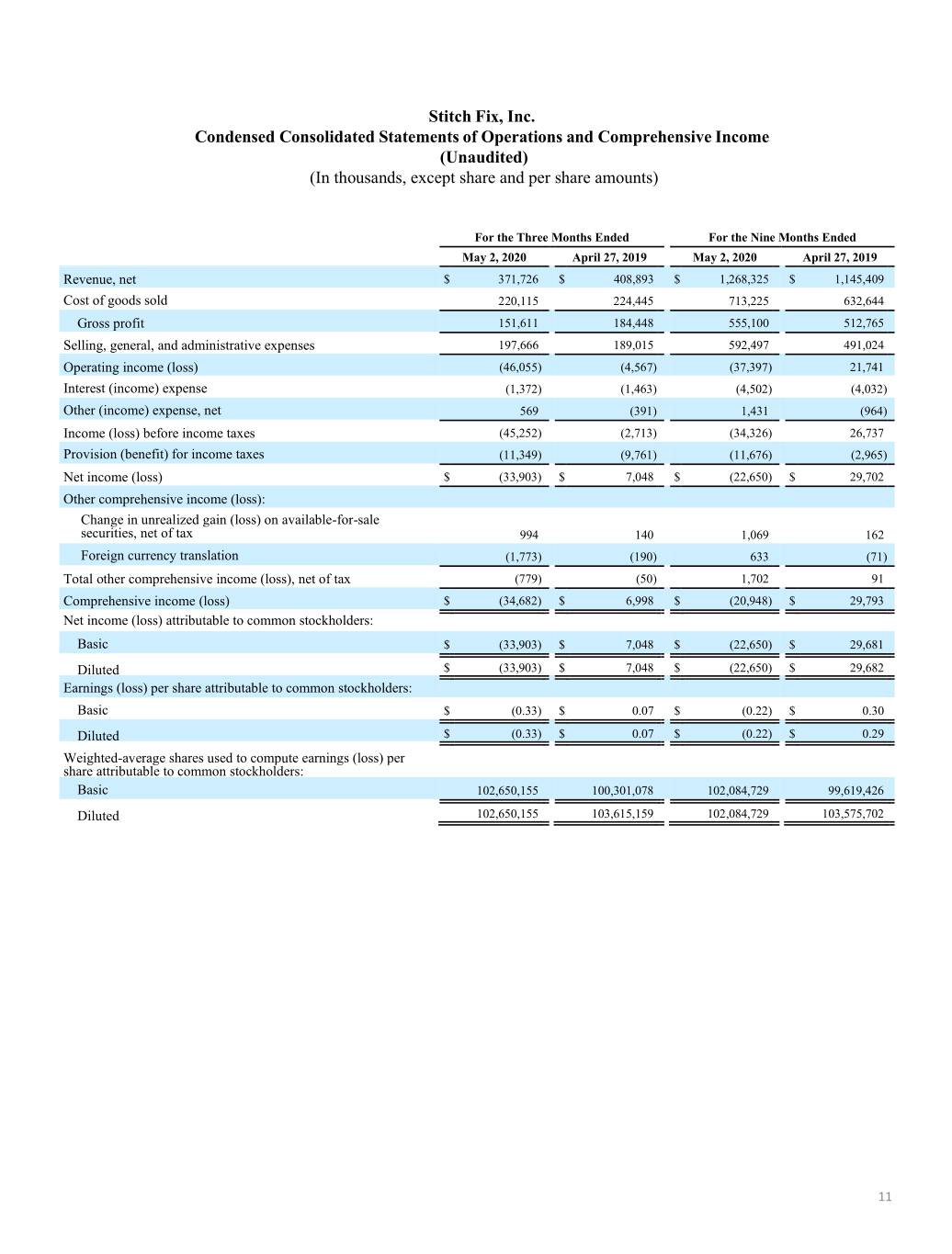
Stitch Fix, Inc. Condensed Consolidated Statements of Operations and Comprehensive Income (Unaudited) (In thousands, except share and per share amounts) For the Three Months Ended For the Nine Months Ended May 2, 2020 April 27, 2019 May 2, 2020 April 27, 2019 Revenue, net $ 371,726 $ 408,893 $ 1,268,325 $ 1,145,409 Cost of goods sold 220,115 224,445 713,225 632,644 Gross profit 151,611 184,448 555,100 512,765 Selling, general, and administrative expenses 197,666 189,015 592,497 491,024 Operating income (loss) (46,055) (4,567) (37,397) 21,741 Interest (income) expense (1,372) (1,463) (4,502) (4,032) Other (income) expense, net 569 (391) 1,431 (964) Income (loss) before income taxes (45,252) (2,713) (34,326) 26,737 Provision (benefit) for income taxes (11,349) (9,761) (11,676) (2,965) Net income (loss) $ (33,903) $ 7,048 $ (22,650) $ 29,702 Other comprehensive income (loss): Change in unrealized gain (loss) on available-for-sale securities, net of tax 994 140 1,069 162 Foreign currency translation (1,773) (190) 633 (71) Total other comprehensive income (loss), net of tax (779) (50) 1,702 91 Comprehensive income (loss) $ (34,682) $ 6,998 $ (20,948) $ 29,793 Net income (loss) attributable to common stockholders: Basic $ (33,903) $ 7,048 $ (22,650) $ 29,681 Diluted $ (33,903) $ 7,048 $ (22,650) $ 29,682 Earnings (loss) per share attributable to common stockholders: Basic $ (0.33) $ 0.07 $ (0.22) $ 0.30 Diluted $ (0.33) $ 0.07 $ (0.22) $ 0.29 Weighted-average shares used to compute earnings (loss) per share attributable to common stockholders: Basic 102,650,155 100,301,078 102,084,729 99,619,426 Diluted 102,650,155 103,615,159 102,084,729 103,575,702 11
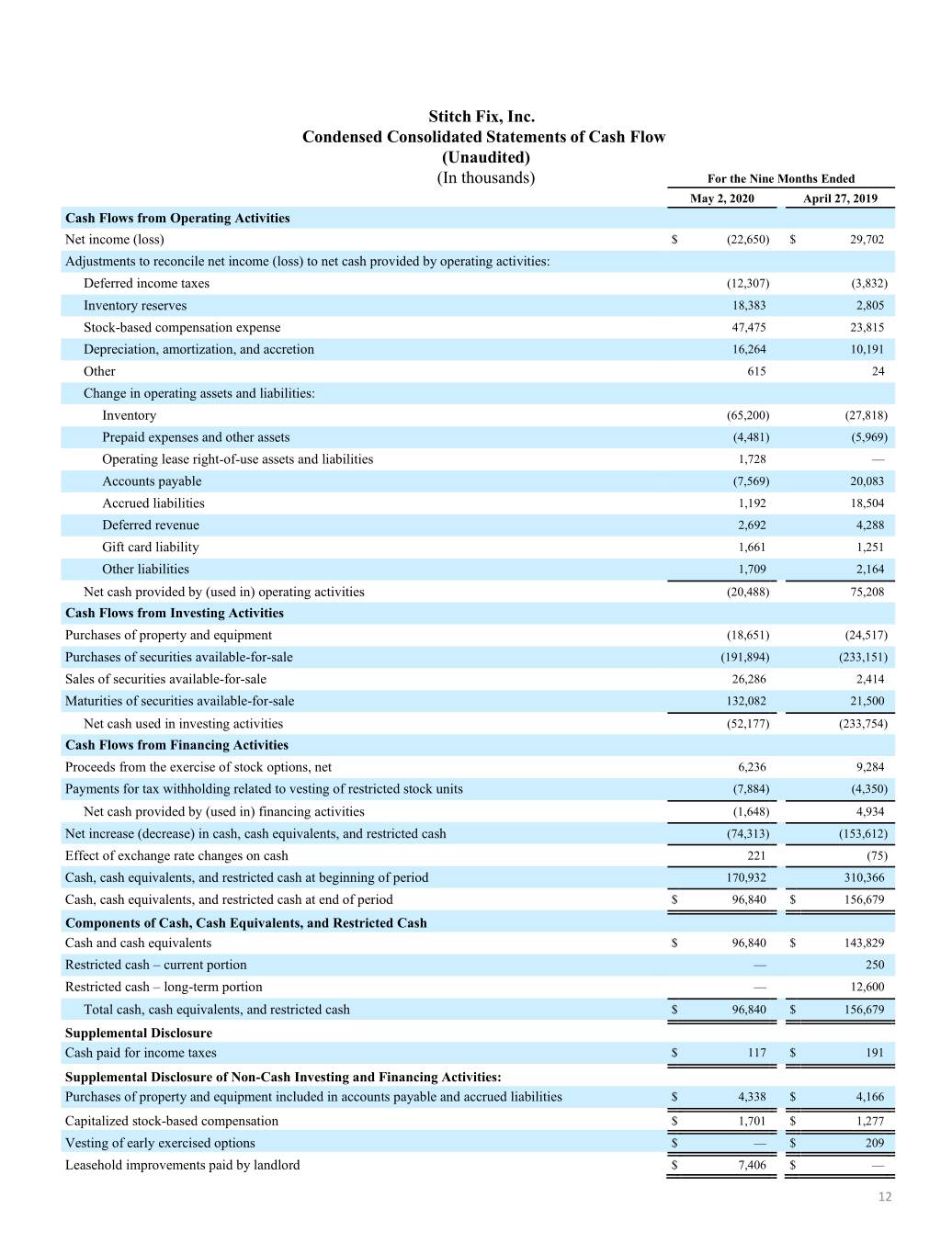
Stitch Fix, Inc. Condensed Consolidated Statements of Cash Flow (Unaudited) (In thousands) For the Nine Months Ended May 2, 2020 April 27, 2019 Cash Flows from Operating Activities Net income (loss) $ (22,650) $ 29,702 Adjustments to reconcile net income (loss) to net cash provided by operating activities: Deferred income taxes (12,307) (3,832) Inventory reserves 18,383 2,805 Stock-based compensation expense 47,475 23,815 Depreciation, amortization, and accretion 16,264 10,191 Other 615 24 Change in operating assets and liabilities: Inventory (65,200) (27,818) Prepaid expenses and other assets (4,481) (5,969) Operating lease right-of-use assets and liabilities 1,728 — Accounts payable (7,569) 20,083 Accrued liabilities 1,192 18,504 Deferred revenue 2,692 4,288 Gift card liability 1,661 1,251 Other liabilities 1,709 2,164 Net cash provided by (used in) operating activities (20,488) 75,208 Cash Flows from Investing Activities Purchases of property and equipment (18,651) (24,517) Purchases of securities available-for-sale (191,894) (233,151) Sales of securities available-for-sale 26,286 2,414 Maturities of securities available-for-sale 132,082 21,500 Net cash used in investing activities (52,177) (233,754) Cash Flows from Financing Activities Proceeds from the exercise of stock options, net 6,236 9,284 Payments for tax withholding related to vesting of restricted stock units (7,884) (4,350) Net cash provided by (used in) financing activities (1,648) 4,934 Net increase (decrease) in cash, cash equivalents, and restricted cash (74,313) (153,612) Effect of exchange rate changes on cash 221 (75) Cash, cash equivalents, and restricted cash at beginning of period 170,932 310,366 Cash, cash equivalents, and restricted cash at end of period $ 96,840 $ 156,679 Components of Cash, Cash Equivalents, and Restricted Cash Cash and cash equivalents $ 96,840 $ 143,829 Restricted cash – current portion — 250 Restricted cash – long-term portion — 12,600 Total cash, cash equivalents, and restricted cash $ 96,840 $ 156,679 Supplemental Disclosure Cash paid for income taxes $ 117 $ 191 Supplemental Disclosure of Non-Cash Investing and Financing Activities: Purchases of property and equipment included in accounts payable and accrued liabilities $ 4,338 $ 4,166 Capitalized stock-based compensation $ 1,701 $ 1,277 Vesting of early exercised options $ — $ 209 Leasehold improvements paid by landlord $ 7,406 $ — 12
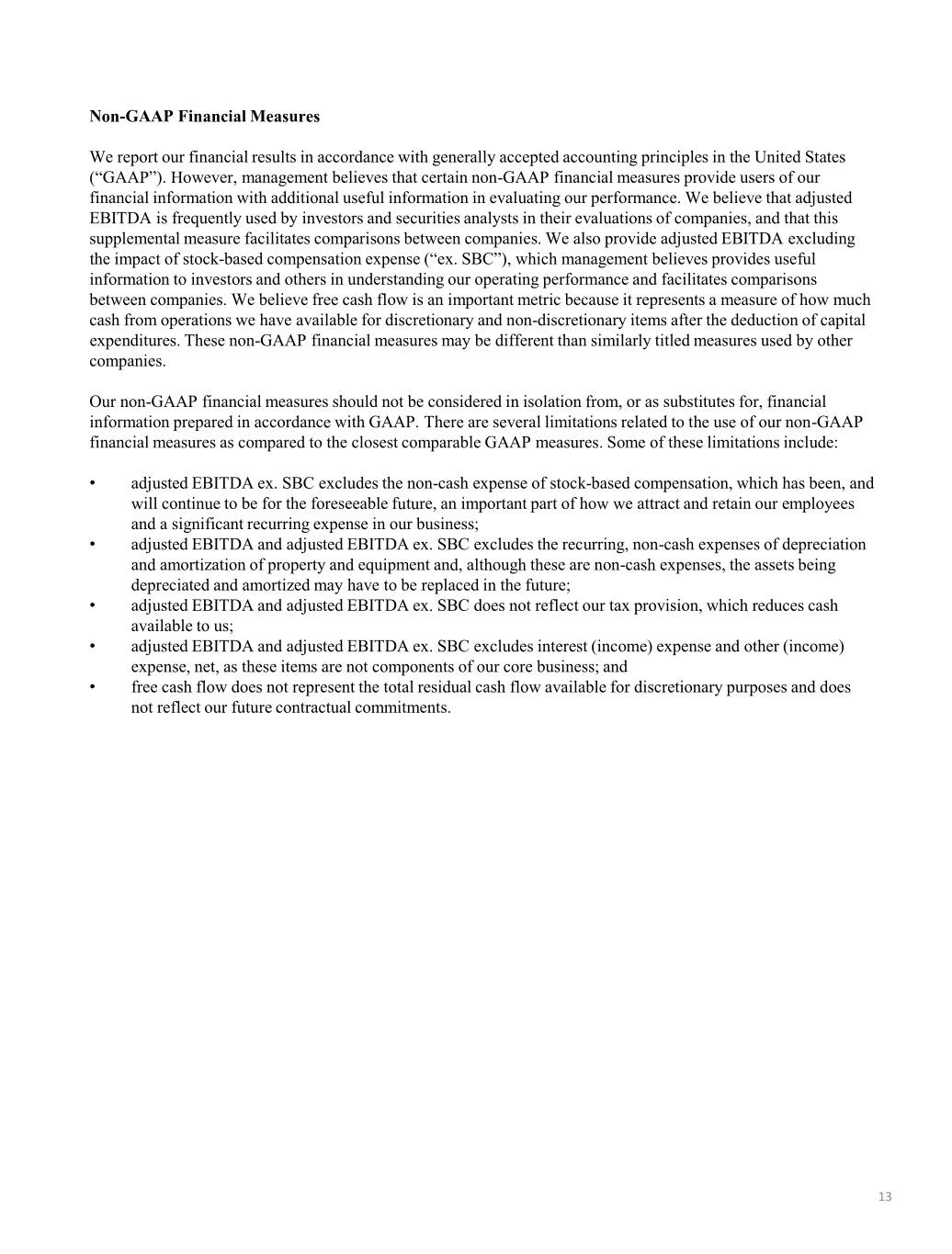
Non-GAAP Financial Measures We report our financial results in accordance with generally accepted accounting principles in the United States (“GAAP”). However, management believes that certain non-GAAP financial measures provide users of our financial information with additional useful information in evaluating our performance. We believe that adjusted EBITDA is frequently used by investors and securities analysts in their evaluations of companies, and that this supplemental measure facilitates comparisons between companies. We also provide adjusted EBITDA excluding the impact of stock-based compensation expense (“ex. SBC”), which management believes provides useful information to investors and others in understanding our operating performance and facilitates comparisons between companies. We believe free cash flow is an important metric because it represents a measure of how much cash from operations we have available for discretionary and non-discretionary items after the deduction of capital expenditures. These non-GAAP financial measures may be different than similarly titled measures used by other companies. Our non-GAAP financial measures should not be considered in isolation from, or as substitutes for, financial information prepared in accordance with GAAP. There are several limitations related to the use of our non-GAAP financial measures as compared to the closest comparable GAAP measures. Some of these limitations include: • adjusted EBITDA ex. SBC excludes the non-cash expense of stock-based compensation, which has been, and will continue to be for the foreseeable future, an important part of how we attract and retain our employees and a significant recurring expense in our business; • adjusted EBITDA and adjusted EBITDA ex. SBC excludes the recurring, non-cash expenses of depreciation and amortization of property and equipment and, although these are non-cash expenses, the assets being depreciated and amortized may have to be replaced in the future; • adjusted EBITDA and adjusted EBITDA ex. SBC does not reflect our tax provision, which reduces cash available to us; • adjusted EBITDA and adjusted EBITDA ex. SBC excludes interest (income) expense and other (income) expense, net, as these items are not components of our core business; and • free cash flow does not represent the total residual cash flow available for discretionary purposes and does not reflect our future contractual commitments. 13
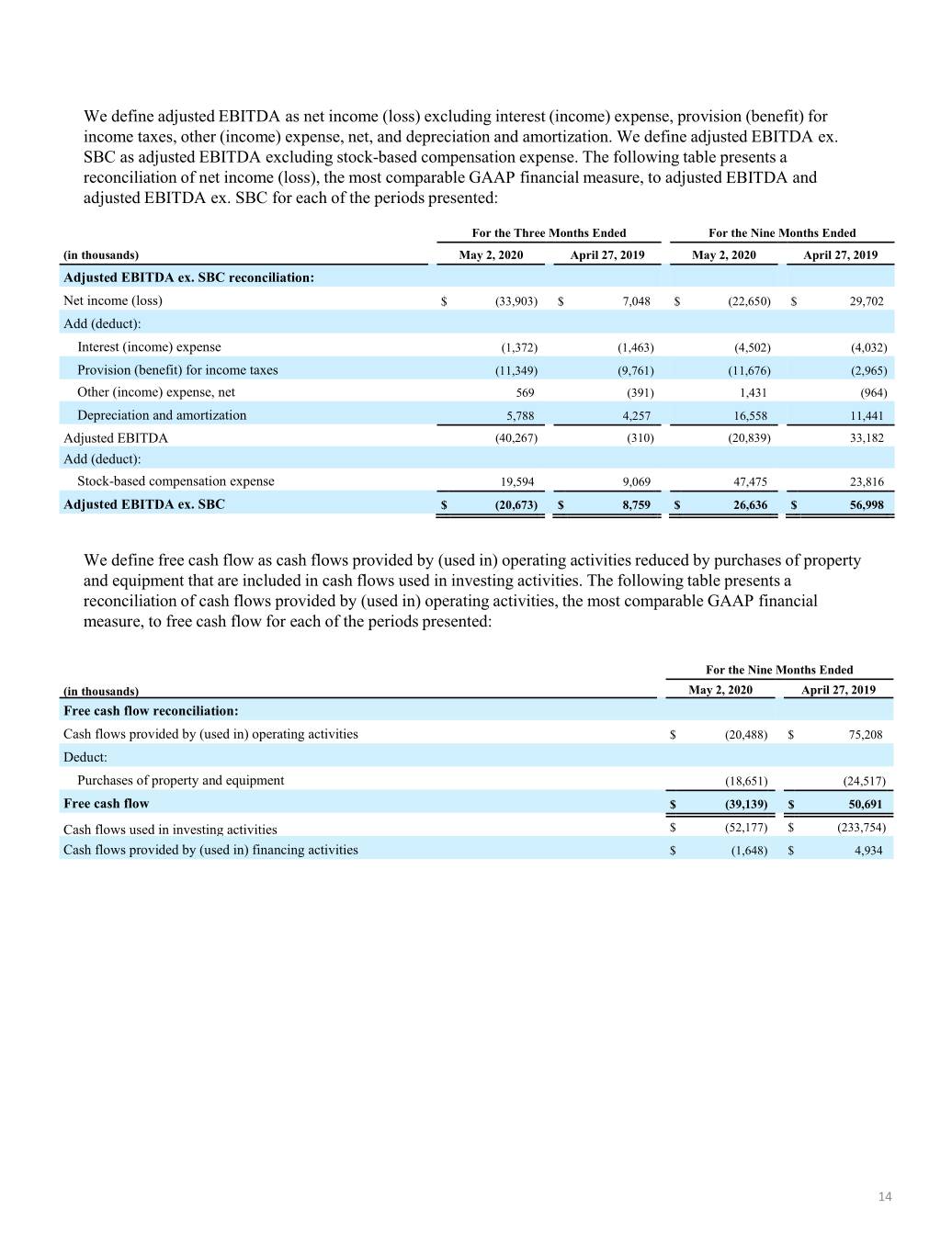
We define adjusted EBITDA as net income (loss) excluding interest (income) expense, provision (benefit) for income taxes, other (income) expense, net, and depreciation and amortization. We define adjusted EBITDA ex. SBC as adjusted EBITDA excluding stock-based compensation expense. The following table presents a reconciliation of net income (loss), the most comparable GAAP financial measure, to adjusted EBITDA and adjusted EBITDA ex. SBC for each of the periods presented: For the Three Months Ended For the Nine Months Ended (in thousands) May 2, 2020 April 27, 2019 May 2, 2020 April 27, 2019 Adjusted EBITDA ex. SBC reconciliation: Net income (loss) $ (33,903) $ 7,048 $ (22,650) $ 29,702 Add (deduct): Interest (income) expense (1,372) (1,463) (4,502) (4,032) Provision (benefit) for income taxes (11,349) (9,761) (11,676) (2,965) Other (income) expense, net 569 (391) 1,431 (964) Depreciation and amortization 5,788 4,257 16,558 11,441 Adjusted EBITDA (40,267) (310) (20,839) 33,182 Add (deduct): Stock-based compensation expense 19,594 9,069 47,475 23,816 Adjusted EBITDA ex. SBC $ (20,673) $ 8,759 $ 26,636 $ 56,998 We define free cash flow as cash flows provided by (used in) operating activities reduced by purchases of property and equipment that are included in cash flows used in investing activities. The following table presents a reconciliation of cash flows provided by (used in) operating activities, the most comparable GAAP financial measure, to free cash flow for each of the periods presented: For the Nine Months Ended (in thousands) May 2, 2020 April 27, 2019 Free cash flow reconciliation: Cash flows provided by (used in) operating activities $ (20,488) $ 75,208 Deduct: Purchases of property and equipment (18,651) (24,517) Free cash flow $ (39,139) $ 50,691 Cash flows used in investing activities $ (52,177) $ (233,754) Cash flows provided by (used in) financing activities $ (1,648) $ 4,934 14
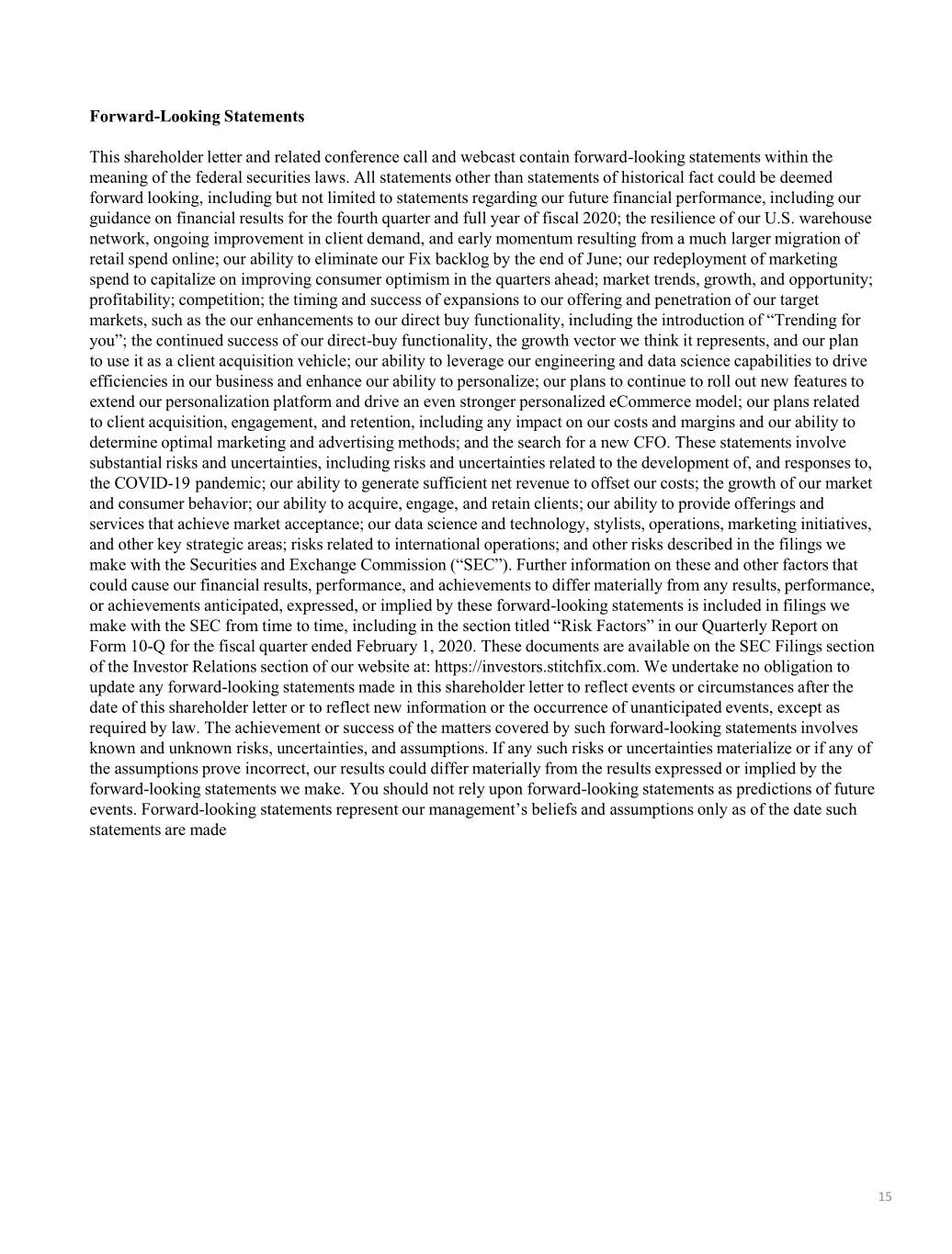
Forward-Looking Statements This shareholder letter and related conference call and webcast contain forward-looking statements within the meaning of the federal securities laws. All statements other than statements of historical fact could be deemed forward looking, including but not limited to statements regarding our future financial performance, including our guidance on financial results for the fourth quarter and full year of fiscal 2020; the resilience of our U.S. warehouse network, ongoing improvement in client demand, and early momentum resulting from a much larger migration of retail spend online; our ability to eliminate our Fix backlog by the end of June; our redeployment of marketing spend to capitalize on improving consumer optimism in the quarters ahead; market trends, growth, and opportunity; profitability; competition; the timing and success of expansions to our offering and penetration of our target markets, such as the our enhancements to our direct buy functionality, including the introduction of “Trending for you”; the continued success of our direct-buy functionality, the growth vector we think it represents, and our plan to use it as a client acquisition vehicle; our ability to leverage our engineering and data science capabilities to drive efficiencies in our business and enhance our ability to personalize; our plans to continue to roll out new features to extend our personalization platform and drive an even stronger personalized eCommerce model; our plans related to client acquisition, engagement, and retention, including any impact on our costs and margins and our ability to determine optimal marketing and advertising methods; and the search for a new CFO. These statements involve substantial risks and uncertainties, including risks and uncertainties related to the development of, and responses to, the COVID-19 pandemic; our ability to generate sufficient net revenue to offset our costs; the growth of our market and consumer behavior; our ability to acquire, engage, and retain clients; our ability to provide offerings and services that achieve market acceptance; our data science and technology, stylists, operations, marketing initiatives, and other key strategic areas; risks related to international operations; and other risks described in the filings we make with the Securities and Exchange Commission (“SEC”). Further information on these and other factors that could cause our financial results, performance, and achievements to differ materially from any results, performance, or achievements anticipated, expressed, or implied by these forward-looking statements is included in filings we make with the SEC from time to time, including in the section titled “Risk Factors” in our Quarterly Report on Form 10-Q for the fiscal quarter ended February 1, 2020. These documents are available on the SEC Filings section of the Investor Relations section of our website at: https://investors.stitchfix.com. We undertake no obligation to update any forward-looking statements made in this shareholder letter to reflect events or circumstances after the date of this shareholder letter or to reflect new information or the occurrence of unanticipated events, except as required by law. The achievement or success of the matters covered by such forward-looking statements involves known and unknown risks, uncertainties, and assumptions. If any such risks or uncertainties materialize or if any of the assumptions prove incorrect, our results could differ materially from the results expressed or implied by the forward-looking statements we make. You should not rely upon forward-looking statements as predictions of future events. Forward-looking statements represent our management’s beliefs and assumptions only as of the date such statements are made 15

16
